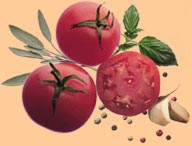
OUR
TOMATOES
Our tomatoes are cultivated in a unique region - a region that will be difficult to match anywhere in the world. Swanpack Fruit CC only uses good quality healthy fresh tomato�s that�s loaded with rich ripe fruit flavors with a clear red colour, high pectin, few pips and high solids.
Sun-dried tomatoes are one of our specialities, so we are eager to expand and deliver the best product we can to the consumer. We have an excellent knowledge of this product.
Tomatoes are today grown worldwide and differ greatly in shape, quality, retention potential and size. The colour is normally light red, red and in some cases yellow. Thus it is evident that tomatoes are grown for the purpose for which they are used. For example, the fresh market requires tomatoes, which are large, have a long shelf life, and are aesthetically pleasing to the eye. For puree and related products, a tomato with other characteristics is required.
Tomatoes in the processed form are a great food resource, worldwide. The potential for the use of processed tomatoes is big and varies from product to product. The most general products and uses are tomato sauces, puree, soups, etc.
Swanpack Fruit CC only uses healthy, fresh tomatoes that are loaded with rich ripe fruit flavours with a clear red colour, high pectin, few pips and high solids. Swanpack only dries tomatoes, which were hand picked and transported a short distance. We only select tomatoes with the best drying properties and are constantly searching for varieties with all these characteristics. We pay particular attention to the flesh and solids content. Yellow tomatoes can also be supplied on request from buyers.
The tomatoes are of an even maturity and of a suitable variety, which gives an even red colour when dried. We dry tomatoes with solids of up to 6.5%, whereas most dried tomatoes produced internationally varies on an average of 3.5% solids. We produce sulphured and unsulphured tomatoes. The sulphur content varies from 130 to 2000 parts per million and can be dried according to demand. A dried tomato loses most of its sulphur during cooking or food preparation. The shelf life and retention capacity of dried tomatoes are not affected by their sulphur content, but rather by the method of packaging and the drying process itself.
We can successfully dry tomatoes from December until the end of April to achieve the highest quality. During these production months we can deliver a product with a moisture content of between 6 and 16% and a percentage of dry solids between 12 and 13%. We provide halves, quarters and various powdered forms from 12mm to 1mm sieve sizes. The dry percentage of tomatoes is 6%; thus 16.5kg of fresh, good quality tomatoes will provide 1kg of dried tomatoes. If you soak a dry tomato in water, the weight should increase five fold.
Our tomatoes are cultivated in a unique region - a region that will be difficult to match anywhere in the world. Swanpack Fruit CC only uses good quality healthy fresh tomato�s that�s loaded with rich ripe fruit flavors with a clear red colour, high pectin, few pips and high solids.
Sun-dried tomatoes are one of our specialities, so we are eager to expand and deliver the best product we can to the consumer. We have an excellent knowledge of this product.
Tomatoes are today grown worldwide and differ greatly in shape, quality, retention potential and size. The colour is normally light red, red and in some cases yellow. Thus it is evident that tomatoes are grown for the purpose for which they are used. For example, the fresh market requires tomatoes, which are large, have a long shelf life, and are aesthetically pleasing to the eye. For puree and related products, a tomato with other characteristics is required.
Tomatoes in the processed form are a great food resource, worldwide. The potential for the use of processed tomatoes is big and varies from product to product. The most general products and uses are tomato sauces, puree, soups, etc.
Swanpack Fruit CC only uses healthy, fresh tomatoes that are loaded with rich ripe fruit flavours with a clear red colour, high pectin, few pips and high solids. Swanpack only dries tomatoes, which were hand picked and transported a short distance. We only select tomatoes with the best drying properties and are constantly searching for varieties with all these characteristics. We pay particular attention to the flesh and solids content. Yellow tomatoes can also be supplied on request from buyers.
The tomatoes are of an even maturity and of a suitable variety, which gives an even red colour when dried. We dry tomatoes with solids of up to 6.5%, whereas most dried tomatoes produced internationally varies on an average of 3.5% solids. We produce sulphured and unsulphured tomatoes. The sulphur content varies from 130 to 2000 parts per million and can be dried according to demand. A dried tomato loses most of its sulphur during cooking or food preparation. The shelf life and retention capacity of dried tomatoes are not affected by their sulphur content, but rather by the method of packaging and the drying process itself.
We can successfully dry tomatoes from December until the end of April to achieve the highest quality. During these production months we can deliver a product with a moisture content of between 6 and 16% and a percentage of dry solids between 12 and 13%. We provide halves, quarters and various powdered forms from 12mm to 1mm sieve sizes. The dry percentage of tomatoes is 6%; thus 16.5kg of fresh, good quality tomatoes will provide 1kg of dried tomatoes. If you soak a dry tomato in water, the weight should increase five fold.